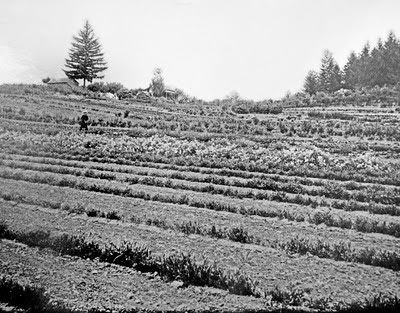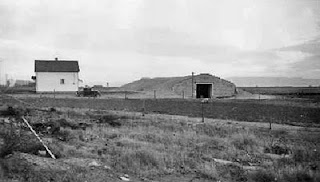 |
| Agricultural experiment plots. Library of Congress. |
However, an early attempt to form "substations" – and thereby qualify for more Hatch grants – failed miserably in the 1890s. Apparently, the University simply didn’t know enough about how to staff the stations with experts suited to local needs.
In 1898, they replaced that effort with a program of traveling institutes, which proved extremely useful, and popular. In little more than a decade, the team of experts and their demonstration paraphernalia required a train of six rail cars to transport them around the state.
The program benefited the presenters as well as the attendees: Traveling faculty observed first-hand those areas and agricultural products that needed more help than they could provide.
After awhile, the university made the extension service a separate adminstrative unit. Before this, the UI President not only ran the University, he was head of the College of Agriculture, which also operated the experiment station. The President recommended (Idaho Statesman, December 28, 1902) that, “the two departments should be divorced and the presidency of the university and agricultural college should not be coupled with the responsibility for the work of the agricultural station.”
With that change, and what they learned from the institute program, the University reactivated the substation system in 1906. The first of the new stations, near Caldwell, soon settled into long-term studies of irrigation techniques and tests of crop varieties suitable to Idaho’s climate and soil.
Administrators remained flexible, however; in 1914 H. T. French described a station near Gooding that no longer existed when Hawley published his History in 1920.
 |
| Potato cellar, Aberdeen Experiment Station, 1932. UI archives. |
Guided by experience and changing conditions, administrators developed a policy whereby each station was designed to address specific regional farm and ranch issues. Thus, the Sandpoint Station, established in 1912, focused on crops that would grow well in the cooler, wetter climate of North Idaho. That same year, the Aberdeen Station began testing potatoes, grains, forage crops, and other plants suitable for irrigated or dry farming in that area.
The Stations also tied into truly international efforts. Hawley noted that “United States Consuls and special agents” of the U. S. Department of Agriculture had been instructed to search the world for plant varieties suited to Idaho’s high altitude and arid climate. He wrote that, “Farming is being reduced to a science and crop failures will soon become a thing of the past.”
Today, the University of Idaho maintains twelve research and extension centers spotted across the state, along with the main campus Center. Their work encompasses all areas related to farming and ranching: water use, soil conservation, animal and plant breeding, pest and disease control, animal care, and even food safety and innovation.
| References: [French], [Hawley] |
| Keith C. Petersen, The Crested Hill: An Illustrated History of the University of Idaho, University of Idaho Press, Moscow (1987). |
| University of Idaho Idaho Agricultural Experiment Station Home. |

No comments:
Post a Comment